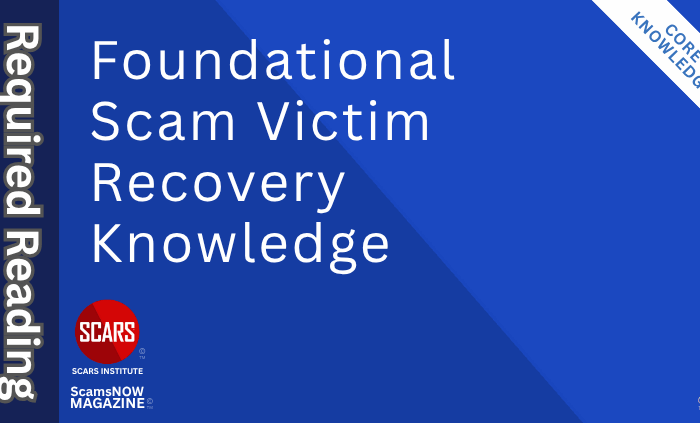
Really Listening to Scam Victims
Listening That Heals: How To Really Hear Scam Victims
Why Listening Matters More Than Fixing
Primary Category: Advocacy / Scam Victim Recovery Psychology
Author:
• Tim McGuinness, Ph.D., DFin, MCPO, MAnth – Anthropologist, Scientist, Polymath, Director of the Society of Citizens Against Relationship Scams Inc.
Author Biographies Below
About This Article
Listening, not fixing, is the first medicine after a relationship scam. Center the survivor’s story, reflect feelings with clear validation, and use consent before advice so dignity and a sense of control can return. Family, advocates, and law enforcement pair compassion with structure by teaching brief regulation skills, honoring boundaries, and routing needs beyond scope to trusted professionals. When a conversation must shift, pause with permission, name the purpose, and pivot gently toward safety or next steps. Practiced consistently, this approach steadies the nervous system, reduces shame, and helps people move from shock to small, doable action.
Note: This article is intended for informational purposes and does not replace professional medical advice. If you are experiencing distress, please consult a qualified mental health professional.

Listening That Heals: How To Really Hear Scam Victims
Author’s Note
This article is about listening. You are about to learn how to listen in a way that helps a scam victim feel believed, safe, and worthy. You will find practical language, simple skills, and clear boundaries you can use in real conversations. If you are a family member or friend, you will see how to support without lecturing or rescuing. If you are an advocate or professional, you will see how to pair compassion with structure so people leave steadier than they arrived. If you serve in law enforcement, you will see how trauma-aware listening builds cooperation while preserving evidence and trust.
Why Listening Matters More Than Fixing
Are you good at listening?
You meet someone who has been deceived, humiliated, and shaken to the core. Your first instinct may be to solve the problem or to point out obvious lessons. Doing that often closes the door you are trying to open. What heals first is not advice. What heals first is being heard. When you truly listen, you give the person a chance to reclaim dignity, make sense of what happened, and begin to trust themselves again. This is the foundation for recovery, whether you are one person offering support, a family member, an advocate, or a professional in law enforcement. The goal is simple: help the person feel safe, believed, and worthy.
What Real Listening Means
Real listening is more than staying quiet. You focus on the person’s experience instead of your opinions. You track their words, tone, and pace. You notice what matters to them, then respond in a way that shows you understand. You replace interruption with curiosity. You honor both the facts of the scam and the feelings that came with it. Validation does not mean agreement with every interpretation. Validation means acknowledging that what they feel makes sense given what they lived through. You signal that reality with simple phrases like “I believe you,” “That sounds devastating,” and “You did not deserve this.” These statements are not decoration. They are lifelines.
Core Principles You Can Use Anywhere
-
- You believe first. Start from the assumption that the person is telling you their truth. Skepticism can wait. The story may be incomplete or tangled. That is normal in the aftermath of trauma.
- You slow down. Give time for the person to find their words. Silence is not failure. Silence is space.
- You reflect, then ask. You show understanding by reflecting a short phrase like “You keep saying you felt ashamed,” then you ask a gentle question such as “What made that shame feel so heavy?”
- You avoid evaluation. You do not rank decisions as smart or foolish. You do not say “I would never have fallen for that.” You do not compare to other people.
- You name strengths. You point to courage, honesty, and persistence already visible in the person’s actions, like reporting the crime or reaching out for help.
- You invite next steps only after the person feels heard. You ask “Would you like ideas, or do you want me to keep listening?” Consent guides the conversation.
One to One: The Practice of Compassionate Presence
When you sit with one person, you become a steady mirror. You keep your phone away. You face them. You let your breathing settle. You start with an invitation: “I am here. Tell me what you want me to know.” Then you follow where they go. If details overwhelm them, you help organize the story without taking control. You might say, “Let’s pause. What was the hardest moment?” or “What feels most important to tell right now?”
If tears come, you do not rush to stop them. If anger rises, you do not argue. You respect the human nervous system doing its best to metabolize shock and grief. When the person apologizes for being emotional, you ground the moment with “You do not need to apologize. This reaction makes complete sense.” When guilt appears, you respond with “You were groomed by a criminal. They engineered this. Your feelings are real, and responsibility for the crime lies with the offender.” These words matter. They do not erase pain, yet they loosen shame.
As trust grows, you can introduce gentle structure. You might close with “What small step would help you feel safer in the next day or two?” You keep steps tiny on purpose. Tiny steps build control.
Listening as a Family Member
Family roles complicate listening. You carry your own fear, anger, and questions. You may feel tempted to lecture or to rescue. Those impulses are understandable, and they rarely help at first contact.
You start by separating your fear from their story. You name your support plainly: “I am on your side,” “I am not here to judge you,” “We will take this one step at a time.” You allow your loved one to decide what to share and when. You resist the urge to chase details or to correct inconsistencies. Early memory after trauma can be fragmented. Coherent narratives arrive later.
You also protect the relationship by setting clear, kind boundaries. If the conversation becomes heated, you can say “I want this to be safe for both of us. Let’s take a short break and come back.” If finances are involved, you address them respectfully. You might say “I hear how urgent this feels. Let us talk with a qualified advisor before taking action.” That phrasing respects the person’s agency while adding guardrails.
Family members can help with logistics when asked. You can search for reputable victim support programs, gather official reporting links, or accompany the person to a meeting. You keep ownership in their hands. You do not fill out forms without consent or retell their story for them. You do not become the spokesperson unless they ask.
Listening as an Advocate
If you serve in an advocate role, you stand in two places at once. You sit with the person’s feelings in the present, and you keep sight of the path forward. Your steadiness, not your speeches, earns trust.
You begin each conversation with an agreement about purpose and scope. You might say “We will spend the first part hearing what happened and how it affected you. After that, if you are open to it, we will talk about options for safety and recovery.” This simple frame prevents drift into rescuing or debate.
You train yourself to listen for themes beneath facts. You reflect identity injuries like “You keep saying you cannot trust yourself. That feeling is common after grooming, and it can change.” You normalize nervous system responses: “Hypervigilance, poor sleep, and looping thoughts often follow betrayal. We can work on ways to settle your system.” Then you teach small skills in the room, such as two or three rounds of paced breathing or a five-sense grounding exercise. When a person feels a little relief in real time, they begin to believe relief is possible without you. That is the point.
You respect referrals. You have a clear list of what belongs with professionals. You explain that referral is part of quality care: “This deserves focused attention with a therapist or legal advisor. I can help you find one, and I will still be here to support you.” You do not offer therapy. You do not provide legal advice. You do not manage crises alone. You do ensure that the person understands next steps and that those steps feel doable.
You also model boundaries while staying warm. You give availability windows. You decline late night private processing. You encourage use of structured groups, hotlines, or scheduled check ins instead of round the clock messaging. This protects both of you and keeps growth moving in the right direction.
Listening as Law Enforcement
If you wear a badge, your listening carries special weight. The person sitting in front of you may feel shame, fear of blame, or frustration after failed attempts to get help. Your approach can either open cooperation or close it.
You acknowledge harm at the outset: “What happened to you was wrong,” “You did not deserve this,” “Thank you for coming in today.” You ask clear, nonleading questions, then give space for answers. You resist commentary about judgment, naivete, or common sense. You use neutral language like “Walk me through the timeline in your own words” and “What did you notice next?”
When you need specific evidence, you explain why: “I am asking for these screenshots to preserve chain of evidence,” “These details help us refer to the right jurisdiction.” You keep tone respectful even when you cannot promise restitution or immediate action. You state limits plainly without minimizing the person’s loss. You may add trusted resources for recovery support, such as victim assistance programs, reputable nonprofit guidance, or trauma informed counseling referrals, including SCARS Institute resources where appropriate. The combination of professionalism and compassion builds trust in a system that may feel impersonal.
Language that Validates
Certain phrases do a great deal of work. Use them sincerely and sparingly, then return to listening.
-
- “I believe you.”
- “This sounds painful and confusing.”
- “You were targeted and groomed by a criminal.”
- “Your reactions make sense.”
- “You are not alone. Many people experience similar feelings after a scam.”
- “Would you like ideas, or would you like me to keep listening?”
- “What would help you feel a little safer today?”
- “We can take this one step at a time.”
Pitfalls to Avoid
-
- Interrupting to correct. Corrections feel like judgment in early conversations. Save edits for paperwork.
- Sermons about caution. General lessons about the internet can wait. Right now, the person needs human acknowledgment.
- Forcing action. Urgency rarely leads to good decisions in the first hours or days. Offer options, not commands.
- Sharing your own story too soon. Self disclosure may be helpful later. Early on, it shifts the focus away from the person who needs to be heard.
- Comparing harm. All losses hurt. Comparison can shame or silence.
- Overpromising. Honest limits preserve trust. If something is unlikely, say so kindly.
The Rhythm of a Helpful Conversation
-
- Start with an invitation. “Tell me what you want me to understand.”
- Listen without interruption. Let the first wave come out.
- Reflect key feelings and facts. “You felt betrayed after months of daily contact.”
- Normalize reactions. “Many people feel shock, shame, and anger after this kind of grooming.”
- Ask for consent to share ideas. “Are you open to options for next steps, or should we stay with listening today?”
- Offer one or two practical options, not ten. Keep choices simple and close to the present.
- Close with a small commitment. “What is one kind thing you can do for yourself today?” or “Would a brief check in tomorrow help?”
Core Rules
Supportive Boundaries that Keep Listening Safe
Good listening includes limits. Limits keep conversations healthy and relationships intact. You can say “I cannot respond overnight, and I will read your message in the morning,” “I cannot manage threats of self harm. If you are in danger, call emergency services,” or “I cannot send money or give personal contact details. I can help you find the right resources.” Clear boundaries are not cold. Clear boundaries are caring. They communicate that you will show up consistently in ways you can sustain.
Caring For Yourself So You Can Keep Listening
Listening to pain day after day can wear anyone down. You protect your capacity with simple habits. You schedule pauses between conversations. You move your body and step outdoors. You debrief with a supervisor or a trusted peer when you feel heavy. You set limits on media that keeps your nervous system on alert. You notice signs of compassion fatigue like irritability, trouble sleeping, or a sense of dread before meetings. When those signs appear, you pull back, rest, and reset. Sustainable helpers last longer and help better.
When Listening Turns Into Action
There comes a time when listening moves toward doing. You keep that transition collaborative. You might say “We have spent time making space for what happened. Would you like to talk through reporting options?” or “Would it help to build a short plan for the next week?” You follow the person’s readiness, not your impatience. You remain aware that recovery is not linear. There will be days of energy and days of exhaustion. You celebrate movement and remain present during stalls.
Working Together Across Roles
One of the most powerful things you can do is to coordinate. Family, advocates, and law enforcement do not need to do everything, and they do need to respect each role. You can share consistent messages that reinforce dignity and agency. You can ensure that your advice does not conflict with professional guidance. You can align on language: “You did not cause this,” “You deserve care,” “We will move step by step.” When a victim hears similar, compassionate phrases from different trusted sources, confidence returns more quickly.
A Simple Checklist You Can Hold In Mind
-
- Am I centering their experience more than my own views.
- Have I validated at least once with a clear sentence like “I believe you.”
- Did I ask for consent before offering options.
- Did I keep my suggestions few and practical.
- Did I protect healthy boundaries while staying warm.
- Did I leave the person with one doable next step.
When and How to Interrupt
Here are clear, compassionate rules for interrupting or changing direction when you are supporting a scam victim. They keep dignity first, protect safety, and preserve the purpose of the conversation.
Guiding principle
You interrupt only to protect safety, protect the person’s dignity, keep boundaries, or return to the shared purpose. You validate first, then redirect with consent.
When it is appropriate to interrupt
-
- Imminent safety concerns, self-harm talk, threats from offenders, doxxing, or stalking
- Escalating panic or dysregulation that needs grounding before continuing
- Harmful self-blame, shame spirals, or dehumanizing language about the person
- Spiraling detail loops that repeat without moving toward needs or next steps
- Boundary issues such as requests for money, off-hours crisis texting, or advice that belongs to professionals
- Time limits approaching when a next step must be set
- Confidentiality or legal risk, such as naming third parties, sharing private info, or asking you to give legal or financial advice
How to interrupt with care
Use this simple sequence.
-
- Pause
- Permission
- Purpose
- Pivot
- Plan
Example in one flow:
-
- “May I pause you for a moment?”
- “I want to keep you safe and supported.”
- “I am hearing your breathing speed up. Can we take thirty seconds to ground?”
- “Then we can come back to the part that matters most to you.”
Scripts you can rely on
Safety
-
-
- “I am going to pause here because I am concerned for your safety. Can we focus on that right now?”
- “If you are in immediate danger, please contact emergency services. I can stay with you while you make that call.”
-
Dysregulation
-
-
- “I hear how intense this feels. May I guide a brief grounding exercise so your body can settle, then we will continue?”
-
Self-blame
-
-
- “I want to stop that phrase for a second. You were groomed by a criminal. Can we choose words that treat you with the same respect I would use for anyone else?”
-
Detail loops
-
-
- “I am hearing the same tough moment replay. Would it be alright if we shift to what you need in the next day or two?”
-
Scope and referrals
-
-
- “I cannot give legal or financial advice. Would you like me to help you find a qualified professional?”
-
Time boundary
-
-
- “We have five minutes left. Let’s choose one small next step so you leave with something concrete.”
-
Consent to redirect
-
-
- “Are you open to a suggestion, or would you prefer I keep listening a bit longer?”
-
Role-specific tips
One-to-one
-
-
- Keep your voice slow and warm. Interrupt with one sentence, not a speech. Return the floor quickly.
- “I want to make sure I am tracking. May I reflect what I heard, then you can correct me?”
-
Family
-
-
- Separate your feelings from their needs.
- “I need to pause myself. I am noticing my own fear. I am here to support you, not to direct you. Can we focus on what you need right now?”
- Use collaborative boundaries: “I cannot lend money, and I can help you set up a plan to talk with a counselor or an advocate.”
-
Advocates
-
-
- Name the frame, then steer gently back to it.
- “I am pausing to hold the group agreement. No cross-talk during shares. We will come back to you in a moment.”
- Replace rescuing with consent and options: “Would you like ideas, or would you like to be heard right now?”
-
Law enforcement
-
-
- Lead with validation, then explain the reason for the redirect.
- “I am going to pause so I can ask for a detail that helps preserve evidence. Then we will return to your account.”
- Avoid judgment language. Keep questions neutral: “Walk me through what happened next.”
-
What not to do when you interrupt
-
- Do not correct facts to prove a point. Save edits for reports or paperwork.
- Do not turn the focus to your story.
- Do not argue emotions. Validate, then ground.
- Do not overtalk. One sentence is enough to pivot.
- Do not ignore consent. Ask before offering ideas.
After you redirect
-
- Reflect the core feeling you heard. “That was terrifying and exhausting.”
- Reconnect to purpose. “We are here to help you feel safer and steadier.”
- Confirm agency. “Does this direction still feel right to you?”
- End with one small, doable step and a clear follow-up. “Tomorrow, would a check-in message help? If yes, what time works?”
Quick checklist you can keep in mind
-
- Did I validate before redirecting.
- Did I ask permission.
- Did I state the purpose for the pause.
- Did I offer a concrete pivot.
- Did I leave them with one next step.
Use these rules and phrases as anchors. You will protect dignity, keep everyone safer, and move the conversation toward real relief without taking control away from the person who needs to be heard.
Conclusion
You do not need perfect words to make a difference. You need presence, respect, and restraint. You listen more than you speak. You allow feelings to exist without trying to erase them. You use short phrases that affirm worth and responsibility placed in the right place, on the offender. You match care with structure so that recovery can begin. When you listen in this way, you help a person move from isolation toward dignity and from shock toward steadiness. That is how healing starts.
Glossary
- Accountability Check-In — A brief closing moment where the person names one realistic next step before the next contact, reinforcing agency and momentum.
- Advocate Availability Window — A clear statement of when the helper is reachable, which protects sustainability and models healthy limits.
- Advocacy Scope — The defined boundaries of non-clinical support; excludes therapy, legal or financial advice, and crisis management while normalizing referrals.
- Boundaried Compassion — Warmth paired with limits that keep both parties safe; exemplified by “I care about this, and I also cannot provide overnight messaging.”
- Boundary Setting — The practice of stating limits on time, money, content, and channels; framed as care rather than rejection.
- Calibrated Questions — Short, non-leading prompts that invite depth without directing outcomes, such as “What felt hardest just now?”
- Chain of Evidence — The law-enforcement requirement to preserve and document digital artifacts; explained with respectful clarity about why items are requested.
- Consent Before Advice — A core norm that asks permission prior to suggestions, often using the consent question “Are you open to ideas, or would you like me to keep listening?”
- Consent Question — The exact phrase that protects autonomy and pace, for example “Would you like ideas, or do you want me to keep listening?”
- Crisis Services Redirect — The immediate handoff to emergency resources when safety is at risk, paired with grounding support while the call is made.
- Detail Loop — A repetitive recounting that no longer adds new information; gently redirected toward needs or next steps with “Would it be alright if we shift to what you need in the next day or two?”
- Dignity Statements — Short acknowledgments that place responsibility on the offender and affirm worth, such as “I believe you,” “You did not deserve this,” and “You were groomed by a criminal.”
- Five-Senses Grounding — A two-minute skill that orients attention to sight, sound, touch, smell, and taste to settle a heightened nervous system.
- Grooming — The criminal process of gradual manipulation and trust-building used to extract money, access, or control.
- Hypervigilance — Heightened scanning for threat that follows betrayal; validated and addressed with regulation skills rather than argument.
- Invitation to Share — A gentle opening that centers the survivor’s pace, such as “I’m here. Tell me what you want me to know.”
- Law-Enforcement Neutral Questioning — Plain, non-judgmental prompts like “Walk me through the timeline in your own words,” paired with reasons for evidence requests.
- Micro-Skills Practice — Brief, repeatable tools taught in the moment (paced breathing, grounding, one-minute planning) so relief is portable beyond the conversation.
- Normalization — Naming that post-scam reactions are common and understandable, for example “Many people feel shock, shame, and anger after this kind of grooming.”
- Observational Listening — Quiet presence that tracks words, tone, and pace without inserting opinions or prematurely solving.
- Off-Platform Contact Limits — Agreed boundaries that keep support within scheduled times and prevent late-night crisis loops or enmeshment.
- Paced Breathing — A slow inhale-exhale pattern practiced together to down-regulate arousal before continuing sensitive discussion.
- Permission–Purpose–Pivot–Plan Sequence — A four-step redirect for interruptions: ask to pause, name the reason, steer gently, and agree on a next step.
- Reflective Listening — Concise mirroring of meaning and feeling, such as “You keep coming back to feeling ashamed,” followed by a gentle question.
- Referral and Stepped Care — Routing needs beyond scope to qualified professionals while the supporter remains present for non-clinical help.
- Safety Planning — A short, concrete focus on immediate protection, including doxxing threats, stalking concerns, and safe communication steps.
- Shame-Language Interruption — A respectful stop to self-attacking phrases with a reframing like “Let’s use words that treat you with the same respect I would use for anyone else.”
- Silence as Space — Allowing pauses so the survivor can find words; treated as presence, not neglect.
- Time Boundary — A clear, kind reminder of remaining minutes to ensure closure and a small, doable commitment before ending.
- Trauma-Informed Validation — Acknowledgment that feelings make sense in light of what was lived, without endorsing every interpretation.
- Victim-Centered Language — Words that place responsibility on offenders and protect dignity, avoiding blame and minimizing phrases.
- Validation Phrases — Simple, high-impact lines used sparingly, including “I believe you,” “This sounds painful and confusing,” and “We can take this one step at a time.”
Author Biographies
-/ 30 /-
What do you think about this?
Please share your thoughts in a comment below!
Important Information for New Scam Victims
- Please visit www.ScamVictimsSupport.org – a SCARS Website for New Scam Victims & Sextortion Victims.
- SCARS Institute now offers its free, safe, and private Scam Survivor’s Support Community at www.SCARScommunity.org – this is not on a social media platform, it is our own safe & secure platform created by the SCARS Institute especially for scam victims & survivors.
- SCARS Institute now offers a free recovery learning program at www.SCARSeducation.org.
- Please visit www.ScamPsychology.org – to more fully understand the psychological concepts involved in scams and scam victim recovery.
If you are looking for local trauma counselors, please visit counseling.AgainstScams.org
If you need to speak with someone now, you can dial 988 or find phone numbers for crisis hotlines all around the world here: www.opencounseling.com/suicide-hotlines
Statement About Victim Blaming
Some of our articles discuss various aspects of victims. This is both about better understanding victims (the science of victimology) and their behaviors and psychology. This helps us to educate victims/survivors about why these crimes happened and not to blame themselves, better develop recovery programs, and help victims avoid scams in the future. At times, this may sound like blaming the victim, but it does not blame scam victims; we are simply explaining the hows and whys of the experience victims have.
These articles, about the Psychology of Scams or Victim Psychology – meaning that all humans have psychological or cognitive characteristics in common that can either be exploited or work against us – help us all to understand the unique challenges victims face before, during, and after scams, fraud, or cybercrimes. These sometimes talk about some of the vulnerabilities the scammers exploit. Victims rarely have control of them or are even aware of them, until something like a scam happens, and then they can learn how their mind works and how to overcome these mechanisms.
Articles like these help victims and others understand these processes and how to help prevent them from being exploited again or to help them recover more easily by understanding their post-scam behaviors. Learn more about the Psychology of Scams at www.ScamPsychology.org
SCARS INSTITUTE RESOURCES:
If You Have Been Victimized By A Scam Or Cybercrime
♦ If you are a victim of scams, go to www.ScamVictimsSupport.org for real knowledge and help
♦ SCARS Institute now offers its free, safe, and private Scam Survivor’s Support Community at www.SCARScommunity.org/register – this is not on a social media platform, it is our own safe & secure platform created by the SCARS Institute especially for scam victims & survivors.
♦ Enroll in SCARS Scam Survivor’s School now at www.SCARSeducation.org
♦ To report criminals, visit https://reporting.AgainstScams.org – we will NEVER give your data to money recovery companies like some do!
♦ Follow us and find our podcasts, webinars, and helpful videos on YouTube: https://www.youtube.com/@RomancescamsNowcom
♦ Learn about the Psychology of Scams at www.ScamPsychology.org
♦ Dig deeper into the reality of scams, fraud, and cybercrime at www.ScamsNOW.com and www.RomanceScamsNOW.com
♦ Scam Survivor’s Stories: www.ScamSurvivorStories.org
♦ For Scam Victim Advocates visit www.ScamVictimsAdvocates.org
♦ See more scammer photos on www.ScammerPhotos.com
You can also find the SCARS Institute’s knowledge and information on Facebook, Instagram, X, LinkedIn, and TruthSocial
Psychology Disclaimer:
All articles about psychology and the human brain on this website are for information & education only
The information provided in this and other SCARS articles are intended for educational and self-help purposes only and should not be construed as a substitute for professional therapy or counseling.
Note about Mindfulness: Mindfulness practices have the potential to create psychological distress for some individuals. Please consult a mental health professional or experienced meditation instructor for guidance should you encounter difficulties.
While any self-help techniques outlined herein may be beneficial for scam victims seeking to recover from their experience and move towards recovery, it is important to consult with a qualified mental health professional before initiating any course of action. Each individual’s experience and needs are unique, and what works for one person may not be suitable for another.
Additionally, any approach may not be appropriate for individuals with certain pre-existing mental health conditions or trauma histories. It is advisable to seek guidance from a licensed therapist or counselor who can provide personalized support, guidance, and treatment tailored to your specific needs.
If you are experiencing significant distress or emotional difficulties related to a scam or other traumatic event, please consult your doctor or mental health provider for appropriate care and support.
Also read our SCARS Institute Statement about Professional Care for Scam Victims – click here
If you are in crisis, feeling desperate, or in despair, please call 988 or your local crisis hotline – international numbers here.
More ScamsNOW.com Articles
A Question of Trust
At the SCARS Institute, we invite you to do your own research on the topics we speak about and publish. Our team investigates the subject being discussed, especially when it comes to understanding the scam victims-survivors’ experience. You can do Google searches, but in many cases, you will have to wade through scientific papers and studies. However, remember that biases and perspectives matter and influence the outcome. Regardless, we encourage you to explore these topics as thoroughly as you can for your own awareness.















![NavyLogo@4x-81[1] Really Listening to Scam Victims - 2025](https://scamsnow.com/wp-content/uploads/2025/04/NavyLogo@4x-811.png)









![scars-institute[1] Really Listening to Scam Victims - 2025](https://scamsnow.com/wp-content/uploads/2025/04/scars-institute1.png)

![niprc1.png1_-150×1501-1[1] Really Listening to Scam Victims - 2025](https://scamsnow.com/wp-content/uploads/2025/04/niprc1.png1_-150x1501-11.webp)
